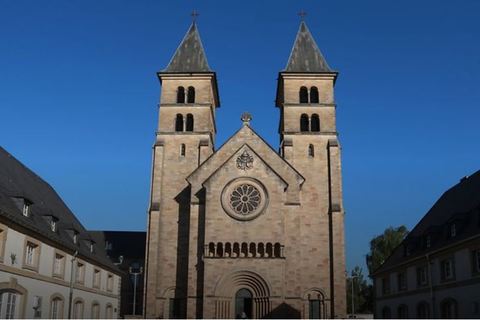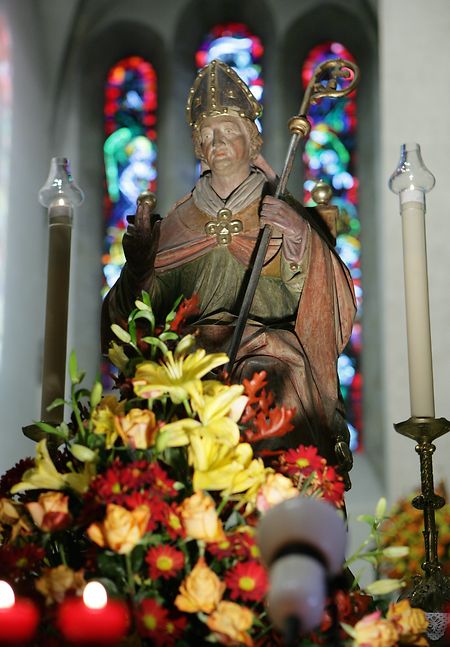
Architectural Icon: Echternach Abbey
Built five times, spanning several centuries, this Romanesque-styled building holds the remains of Saint Willibrord
The architectural centrepiece of the medieval town of Echternach is undoubtedly the basilica and abbey complex. The one you see today is the fifth version to be erected in a long history that starts with Saint Willibrord.
Who was Saint Willibrord?
Willibrord was born in Northumbria, and as a young monk he lived in Ireland. In 690 he crossed into Europe with 11 other Irish monks to undertake missionary work. His pragmatism led to support from Pepin II of Herstal whose nobles granted him the land that Echternach Abbey/Basilica is built upon. He died in 739 at the ripe age of 81 years, and his body was interred in the crypt of the abbey. His missionary work took him into Belgium and the Netherlands, where there still remain a number of parish churches linked to him. Upon death and sainthood, pilgrims came from across this region to visit his grave.
A history of the abbey and basilica
Willibrord built his original abbey with donations from Pepin II and the Abbess Irmina of Oeren (near Trier). After his death the church (now the basilica) of the abbey was considered too small to cater to the number of pilgrims visiting his grave, and at the start of the ninth century a second, larger, Carolingian-style church was constructed, but was destroyed some 200 years later in a fire.
In 1031 a new Romanesque church was consecrated, which was a similar size to the basilica today. During the 13th century gothic ornamentations were added to its interior, and in the 17th century various chapels, including the one to St Sebastian that is located to the right of the choir, were added.
The fortunes of the church and abbey complex took a turn for the worse after the French Revolution, when French troops plundered and desecrated the church in 1794. Three years later it was sold at auction and served as a pottery works and military drill yard for the first half of the 19th century. By 1850 the church was in ruins.

In 1862 to burghers of Echternach formed the "Willibrodus Bauverein" to collect money for restoration, and the church was consecrated again six years later. In 1906 the remains of Willibrord which had also been plundered, were returned to their original crypt. In 1939, on the eve of war, the church was granted the rank of papal basilica by Pope Pius XII.
In 1944 retreating German troops blew up the basilica causing serious damage to the western section. Post-war reconstruction tried to maintain the Romanesque origins and was inspired by the design of the basilica in Paray-le-Monial, to include two towers and a façade. The basilica you see today was opened in 1953.
Famous scripts
Echternach Abbey was also home to the most important scriptoria in the Frankish empire, which produced four gospels – the Augsberg gospel, the Maaseyck gospel, the Trier gospel and the Freiburg gospel. The 9th century was the scriptoria's heyday, after which the power of the Carolingians fell and with it that of the monks, who were later replaced by lay abbots in 847. However Otto the Great restored the monks to the abbey in 971 and in the 11th century the Codex Aureus of Echternach was produced entirely in gold ink.
Inside the basilica
The simplistic nave has alternating supports, where large arches rest on pillars and the smaller two arches rest on columns. The aisles are gothic and adorned with stained glass windows that portray the life of Saint Willibrord. In the choir window the saint is standing between the apostles Peter and Paul, under an image of the Holy Trinity, whilst the upper windows depict those who played an important part in the saint's life.
Above the organ, a rose window lets in light and is decorated with the signs of the zodiac. The confession alter in the lower choir area links to Saint Willibrord's grave and crypt, providing a light shaft. You'll also find two wooden statues from the early 18th century of St Benedict and St Willibrord. A painting from 1605 of pilgrims shows the first dancing or hopping procession, whilst the baptistry also houses the remains of the saint's robe.

Below the basilica a five-aisle crypt that dates back to Carolingian times houses the saints tomb, which is made from Carrara marble. Eleventh century frescos adorn the ceiling, showing scenes from the life of the Virgin Mary, and there is also a font, representing the vast amount of baptising (mostly in rivers and springs) that the saint performed in the Benelux region in his role as a missionary.
The Echternach dancing or hopping procession takes place on Whit Tuesday each year, and is a UNESCO World Heritage cultural tradition. It attracts people from across the region.
Next to the basilica buildings you'll find the orange garden complete with statues of the four seasons sculpted by Ferdinand Tietz from Würzburg in Germany. There's also a Rococo pavilion built in 1761 by Paul Mugenast (who also built the church in Munneref), which has an elegant staircase leading to the 100m² first floor room that houses an audio-visual presentation of Echternach Abbey's influence on rural architecture. Information panels near the pavilion give details of the abbey's garden.
The museum
The quadrilateral building next to the basilica is where you'll find the museum. The building dates back to 1727 and is in Lothringen style (to look like a princely residence), designed by architect Leopold Durand from Saint Avold in France (he has a street in Echternach named after him). The abbey quarters were dissolved in 1779 and in 1899 the premises became a school. After extension damage in the Second World War, the building was also reconstructed.
The museum is located in the vaulted cellars and is mainly dedicated to the Echternach scriptorium. The decorative first letters of the gospels, painted in gold, are outstanding works of art and Romanesque symbolism. Pages from the 11th century Codex Aureus of Echternach are also on display.
The museum is open from Palm Sunday (April) to Toussaint (1 November) every day from 10.00 to 12.00 and 14.00 to 17.00. Entrance is free for children and €3 for adults, and audio guides in English are available. One-hour"top secret" tours allow visitors to see the cloister and admire the restored former dining room of the monks.
